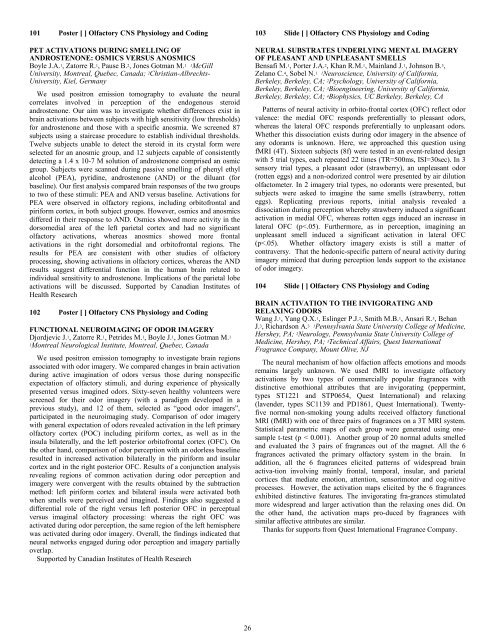Givaudan-Roure Lecture - Association for Chemoreception Sciences
Givaudan-Roure Lecture - Association for Chemoreception Sciences
Givaudan-Roure Lecture - Association for Chemoreception Sciences
Create successful ePaper yourself
Turn your PDF publications into a flip-book with our unique Google optimized e-Paper software.
101 Poster [ ] Olfactory CNS Physiology and Coding<br />
PET ACTIVATIONS DURING SMELLING OF<br />
ANDROSTENONE: OSMICS VERSUS ANOSMICS<br />
Boyle J.A. 1, Zatorre R. 1, Pause B. 2, Jones Gotman M. 1 1McGill<br />
University, Montreal, Quebec, Canada; 2Christian-Albrechts-<br />
University, Kiel, Germany<br />
We used positron emission tomography to evaluate the neural<br />
correlates involved in perception of the endogenous steroid<br />
androstenone. Our aim was to investigate whether differences exist in<br />
brain activations between subjects with high sensitivity (low thresholds)<br />
<strong>for</strong> androstenone and those with a specific anosmia. We screened 87<br />
subjects using a staircase procedure to establish individual thresholds.<br />
Twelve subjects unable to detect the steroid in its crystal <strong>for</strong>m were<br />
selected <strong>for</strong> an anosmic group, and 12 subjects capable of consistently<br />
detecting a 1.4 x 10-7 M solution of androstenone comprised an osmic<br />
group. Subjects were scanned during passive smelling of phenyl ethyl<br />
alcohol (PEA), pyridine, androstenone (AND) or the diluant (<strong>for</strong><br />
baseline). Our first analysis compared brain responses of the two groups<br />
to two of these stimuli: PEA and AND versus baseline. Activations <strong>for</strong><br />
PEA were observed in olfactory regions, including orbitofrontal and<br />
piri<strong>for</strong>m cortex, in both subject groups. However, osmics and anosmics<br />
differed in their response to AND. Osmics showed more activity in the<br />
dorsomedial area of the left parietal cortex and had no significant<br />
olfactory activations, whereas anosmics showed more frontal<br />
activations in the right dorsomedial and orbitofrontal regions. The<br />
results <strong>for</strong> PEA are consistent with other studies of olfactory<br />
processing, showing activations in olfactory cortices, whereas the AND<br />
results suggest differential function in the human brain related to<br />
individual sensitivity to androstenone. Implications of the parietal lobe<br />
activations will be discussed. Supported by Canadian Institutes of<br />
Health Research<br />
102 Poster [ ] Olfactory CNS Physiology and Coding<br />
FUNCTIONAL NEUROIMAGING OF ODOR IMAGERY<br />
Djordjevic J. 1, Zatorre R. 1, Petrides M. 1, Boyle J. 1, Jones Gotman M. 1<br />
1Montreal Neurological Institute, Montreal, Quebec, Canada<br />
We used positron emission tomography to investigate brain regions<br />
associated with odor imagery. We compared changes in brain activation<br />
during active imagination of odors versus those during nonspecific<br />
expectation of olfactory stimuli, and during experience of physically<br />
presented versus imagined odors. Sixty-seven healthy volunteers were<br />
screened <strong>for</strong> their odor imagery (with a paradigm developed in a<br />
previous study), and 12 of them, selected as “good odor imagers”,<br />
participated in the neuroimaging study. Comparison of odor imagery<br />
with general expectation of odors revealed activation in the left primary<br />
olfactory cortex (POC) including piri<strong>for</strong>m cortex, as well as in the<br />
insula bilaterally, and the left posterior orbitofrontal cortex (OFC). On<br />
the other hand, comparison of odor perception with an odorless baseline<br />
resulted in increased activation bilaterally in the piri<strong>for</strong>m and insular<br />
cortex and in the right posterior OFC. Results of a conjunction analysis<br />
revealing regions of common activation during odor perception and<br />
imagery were convergent with the results obtained by the subtraction<br />
method: left piri<strong>for</strong>m cortex and bilateral insula were activated both<br />
when smells were perceived and imagined. Findings also suggested a<br />
differential role of the right versus left posterior OFC in perceptual<br />
versus imaginal olfactory processing: whereas the right OFC was<br />
activated during odor perception, the same region of the left hemisphere<br />
was activated during odor imagery. Overall, the findings indicated that<br />
neural networks engaged during odor perception and imagery partially<br />
overlap.<br />
Supported by Canadian Institutes of Health Research<br />
26<br />
103 Slide [ ] Olfactory CNS Physiology and Coding<br />
NEURAL SUBSTRATES UNDERLYING MENTAL IMAGERY<br />
OF PLEASANT AND UNPLEASANT SMELLS<br />
Bensafi M. 1, Porter J.A. 2, Khan R.M. 1, Mainland J. 1, Johnson B. 3,<br />
Zelano C. 4, Sobel N. 1 1Neuroscience, University of Cali<strong>for</strong>nia,<br />
Berkeley, Berkeley, CA; 2Psychology, University of Cali<strong>for</strong>nia,<br />
Berkeley, Berkeley, CA; 3Bioengineering, University of Cali<strong>for</strong>nia,<br />
Berkeley, Berkeley, CA; 4Biophysics, UC Berkeley, Berkeley, CA<br />
Patterns of neural activity in orbito-frontal cortex (OFC) reflect odor<br />
valence: the medial OFC responds preferentially to pleasant odors,<br />
whereas the lateral OFC responds preferentially to unpleasant odors.<br />
Whether this dissociation exists during odor imagery in the absence of<br />
any odorants is unknown. Here, we approached this question using<br />
fMRI (4T). Sixteen subjects (8f) were tested in an event-related design<br />
with 5 trial types, each repeated 22 times (TR=500ms, ISI=30sec). In 3<br />
sensory trial types, a pleasant odor (strawberry), an unpleasant odor<br />
(rotten eggs) and a non-odorized control were presented by air dilution<br />
olfactometer. In 2 imagery trial types, no odorants were presented, but<br />
subjects were asked to imagine the same smells (strawberry, rotten<br />
eggs). Replicating previous reports, initial analysis revealed a<br />
dissociation during perception whereby strawberry induced a significant<br />
activation in medial OFC, whereas rotten eggs induced an increase in<br />
lateral OFC (p

















